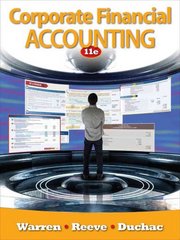The effects of transactions on shareholder's equity The following are possible transactions that effect shareholder's equity: A company issues common stock above par value for
The effects of transactions on shareholder's equity
The following are possible transactions that effect shareholder's equity:
- A company issues common stock above par value for cash.
- A company declares a 3-for-1 stock split.
- A company repurchases 10,000 shares of its own common stock in exchange for cash.
- A company declares and issues a stock dividend. Assume that the fair market value of the stock is greater than the par value.
- A company reissues 1,000 shares of treasury stock for $75 per share. The stock was acquired for $60 per share.
- A company pays a cash dividend that had been declared fifteen days earlier.
- A company generates net income of $250,000.
Accounts Account Stockholders' Equity
(1.1) Common Stock Increase Increase
(1.2) Additional Paid-In Capital, C/S Increase
(2) None N/A No effect
(3)
(4.1)
(4.2)
(4.3)
(5.1) Treasury Stock Decrease Increase
(5.2)
(6)
(7) Increase
For each transaction above, indicate the following:
- a. The accounts within the shareholders' equity section that would be affected.
- b. Whether these accounts would be increased or decreased.
- c. The effect (increase, decrease, or no effect) of the transaction on total shareholders' equity.
Exercise 12-2 on page 532
Debt, contributed and earned capital, and the classification of preferred stock
The balance sheet of Lamont Bros. follows:
| ASSETS | LIABILITIES AND SHAREHOLDERS' EQUITY | ||
| Current assets | $ 85,000 | Current liabilities | $ 52,000 |
| Noncurrent assets | 315,000 | Long-term note payable | 35,000 |
| Preferred stock | 50,000 | ||
| Common stock | 80,000 | ||
| Additional paid-in capital: | |||
| Preferred stock | 50,000 | ||
| Common stock | 100,000 | ||
| Retained earnings | 113,000 | ||
|
| Less: Treasury stock | (80,000) | |
| Total assets | $400,000 | Total liabilities and shareholders' equity | $400,000 |
- a. What portions of Lamont's assets were provided by debt, contributed capital, and earned capital? Reduce contributed capital by the cost of the treasury stock.
- b. Compute the company's debt/equity ratio. Compute the debt/equity ratio if the preferred stock issuance was classified as a long-term debt.
- c. In most states, to what dollar number of dividends would the company be limited?
A Double taxation
B .Market value
c. None
d common stock
e. none
f publicily owned corporation
g paid in capital
h Retained earnings
i none
j none
a.
Debt Liabilities
Contributed Capital = Preferred Stock + Common Stock + Additional Paid-In Capital, Preferred Stock + Additional Paid-In Capital, Common Stock Treasury Stock
Earned Capital = Retained Earnings
What is the Porportion of each to Total Assets?
b.
b.1 Debt/Equity = Total Liabilities Stockholders' Equity
= Total Liabilities (Contributed Capital + Earned Capital)
b.2 Debt/Equity = Total Liabilities Total Stockholders' Equity
= (Total Liabilities + Contributed Preferred Capital) (Contributed Common Capital + Earned Capital Treasury Stock)
Exercise 12-3 on pages 532-533
Authorizing and issuing preferred and common stock
Deming Contractors was involved in the following events involving stock during 2015:
- Authorized to issue: (a) 100,000 shares of $100 par value, 8 percent preferred stock; (b) 150,000 shares of no-par, $5 preferred stock; and (c) 250,000 shares of $5 par value, common stock.
- Issued 10,000 shares of $5 par value common stock for $30 per share.
- Issued 25,000 shares of the $100 par value preferred stock for $150 per share.
- Issued 50,000 shares of no-par preferred stock for $50 each.
Prepare entries, if appropriate, for each event, describe how each event affects the basic accounting equation, and explain the economic significance of par value.
Page 1 of 2 of Problem Assistant for Week ,
(1)
(2) Cash (+A)................................................................................... 300,000
Common Stock (+SE)............................................................. ?
Additional Paid-In Capital, Common Stock (+SE)....................... 250,000
Issued common stock.
(3)
Issued preferred stock.
(4)
Issued preferred stock.
Step by Step Solution
There are 3 Steps involved in it
Step: 1

See step-by-step solutions with expert insights and AI powered tools for academic success
Step: 2

Step: 3

Ace Your Homework with AI
Get the answers you need in no time with our AI-driven, step-by-step assistance
Get Started


